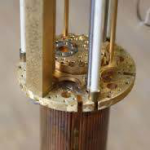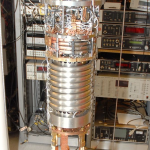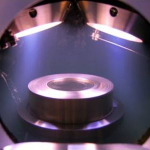

- Photon Transport in a Bose-Hubbard Chain of Superconducting Artificial Atoms
G. P. Fedorov et al., Phys. Rev. Lett. 126, 180503 (2021) - Path-Dependent Supercooling of the
He3 Superfluid A-B Transition
Dmytro Lotnyk et al., Phys. Rev. Lett. 126, 215301 (2021) - Superconductivity in an extreme strange metal
D. H. Nguyen et al., Nat Commun 12, 4341 (2021) - High-Q Silicon Nitride Drum Resonators Strongly Coupled to Gates
Xin Zhou et al., Nano Lett. 21, 5738-5744 (2021) - Measurement of the 229Th isomer energy with a magnetic micro-calorimeter
T. Sikorsky et al., Phys. Rev. Lett. 125 (2020) 142503
A SQUID based read-out of sub-attonewton force sensor operating at millikelvin temperatures
O. Usenko, A. Vinante, G. Wijts, T.H. Oosterkamp
An increasing number of experiments require the use of ultrasensitive nanomechanical resonators. Relevant examples are the investigation of quantum effects in mechanical systems or the detection of exceedingly small forces as in Magnetic Resonance Force Microscopy (MRFM). The force sensitivity of a mechanical resonator is typically limited by thermal fluctuations, which calls for detection methods capable of operating at ultralow temperature. Commonly used interferometric techniques, despite their excellent sensitivity, may not be an optimal choice at millikelvin temperatures, because of unwanted resonator heating caused by photon absorption. Although alternative detection techniques based on microwave cavities have shown to perform better at ultralow temperature, these techniques still suffer from the fact that the detection sensitivity decreases as the power input is decreased.
Here, we present a measurement approach based on the detection, through a Superconducting Quantum Interference Device (SQUID), of the change of magnetic flux induced in a coil by the motion of a magnetic particle attached to a resonator. This detection scheme avoids direct heating of the resonator, as it does not involve reflecting optical or microwave photons to the resonator. By cooling an ultrasoft silicon resonator to 25 mK, we achieve a force noise of 0.5 aN in a 1 Hz bandwidth. We believe this detection technique can in principle be used even at sub-millikelvin temperatures. Furthermore, it could be used to improve the sensitivity of MRFM experiments, which aim at three dimensional imaging at atomic resolution.
Appl. Phys. Lett. 98, 133105 (2011)
doi: 10.1063/1.3570628















